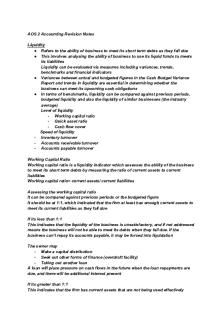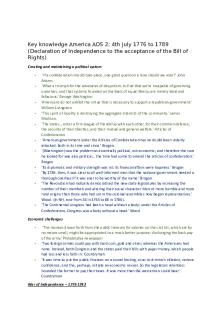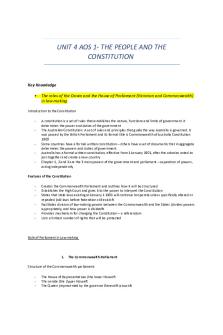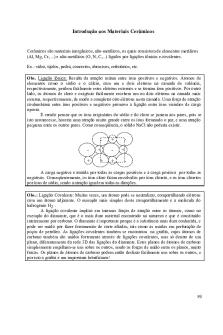AOS 2 notes PDF

| Title | AOS 2 notes |
|---|---|
| Author | Chloe Miles |
| Course | Legal Studies |
| Institution | Victorian Certificate of Education |
| Pages | 16 |
| File Size | 297.9 KB |
| File Type | |
| Total Downloads | 5 |
| Total Views | 188 |
Summary
VCE legal studies year 11 unit 2 AOS 2 notes...
Description
UNIT 2: AREA OF STUDY 2: CIVIL REMEDIES CHAPTER 13 13.1- Introduction to Remedies CIVIL LAW: BASICS In civil law: -
The plaintiff is the person who commences a civil action The defendant is the person being sued A plaintiff and a defendant can be a human being, a company or an association
The plaintiff has the burden of proof in civil disputes and may be able to use a variety of dispute resolution bodies to be compensated for the infringement of civil law.
13.2- The Principles of Justice in Civil Law FAIRNESS, EQUALITY, ACCESS DESCRIPTION
FEATURES OF CIVIL LAW THAT ENSURE FAE
FAIRNESS - Same opportunities - Punishment appropriate to offence - Being informed - Balanced - Making just decisions - Balance of probabilities, the fact that outcomes come outs after evidence has been assessed - Both parties heard - Impartial judge - Burden of
ACCESS - Clear understanding - Pursue their case - Legal representation - Available
-
-
-
Ability to appeal Access to free legal representation Access to an impartial judge Access to an interpreter Knowing your case and possible
EQUALITY - Same opportunities - Unbiased - Same outcomes - No discrimination
-
-
Equal opportunity to present facts and evidence All people are treated the same
-
FEATURES OF CIVIL LAW THAT DO NOT ENSURE FAE
-
proof rests with the plaintiff who’s bringing the case forward Opportunity for a jury Chance to appeal the decision Remedies are proposed Representing yourself Specialised courts Limitations of actions
-
-
charges Compensation Access to a /mediator/ arbitrator
Denied appeal Case dismissed if not enough evidence
-
Compensation that is not the same for similar cases
13.3- Methods used to resolve a civil dispute ALTERNATIVE DISPUTE RESOLUTION METHODS
Mediation -
Mediation is a cooperative method of resolving disputes Is a joint problem-solving process Parties sit down and discuss the issues they disagree and try to reach an agreement through negotiation They do this with the help of a mediator, who is neutral and impartial Mediators are trained to assist the parties in reaching a decision The mediator helps both parties feel more in control of the situation and confident during negotiations The mediator discusses the issues and provides the parties with support Don’t have to have legal skills but need to have good people skills and a high level of conflict resolution skills Mediation is suitable when the parties want to control the outcome, rather than someone else decide it Focus is on settling the matter Finding a compromise between two parties Seeking equality and justice People choose mediation over a court trial: to save legal costs, allows people to understand what the other side is saying, wok through their dispute The court can be involved in mediation: liability or quantum Avoids the risk of losing and winning Very stressful to go through court proceeding In court claims, the risk of paying the defendant’s cost if lost is viable Offers a resolution both parties can participate in Main focus is primarily justice: both parties having their say A win-win outcome
Conciliation -
Process of dispute resolution involving the assistance of an independent third party, with the aim of enabling the parties to reach a decision Similar to mediation but the role if the third party (conciliator) is different The conciliator listens to both sides of the dispute and makes suggestions about appropriate ways of resolving the matter The conciliator is someone with specialist knowledge and explores solutions with the parties’ final decisions is made by the parties and is not binding Conciliation is suitable when the parties want to reach an agreement on some technical and legal issues and want advice on the facts in the dispute Suitable when parties want to control the outcome rather than have it decided by someone else
Strengths of mediation and conciliation
-
A decision made by the parties is more likely to be acceptable to the parties Held in a more informal atmosphere than a court room, can help alleviate stress Less confrontational than a court room, without witnesses and examination
Weaknesses of mediation and conciliation -
The participation and willingness of both parties is required for mediation or conciliation to be successful Not binding on the parties Mediator and conciliator have no power to order the parties to come to a decision
Arbitration -
More formal than mediation or conciliation In arbitration, there is a much greater need for you and the other participants to produce evidence (facts) Less formal than a court process Involves an independent third party- the arbitrator, who listens to the parties and tries to help them reach an agreement If this is not possible, the arbitrator makes a binding decision on the parties The arbitrator will generally have knowledge of the subject matter and of the applicable law Arbitrators are responsible for deciding the outcome of the dispute Can be expensive
Strengths of arbitration -
Decisions are binding on the parties The third party will have expertise in resolving these types of matters, the third party has expertise in these matters Can be cheaper than resolving the dispute through a court process
Weaknesses of arbitration -
It can take a long time for parties to reach a decision, as they have o go through the evidence More expensive than other ADR’s as legal expertise is involved The parties have no control on the outcome
13.4 - Tribunals TRIBUNALS AS A DISPUTE RESOLUTION METHOD -
These are institutions that resolve civil disputes Like courts, but inferior ADR’s are methods Tribunals are gone to if parties are unable to reach a resolution between themselves Courts are often seen as the main bodies that parties can go to, but tribunals also operate for this matter
Tribunals -
-
Any person or institution with authority to judge, adjudicate on, or determine claims or disputes Tribunals are dispute resolution bodies which obtain their power from parliament to resolve certain types of disputes, e.g the Mental Health Act 2014 established the Mental Health Tribunal giving it power to hear applications to determine whether neurosurgery for mental illness should be performed Tribunals develop expertise in a particular type of disputes and are able to kae binding decisions on the parties Saves money and time of going to court Tribunals are similar to courts in that an independent third party will hear the dispute, to make a legally binding decision Tribunals are not as expensive to access like courts are In a tribunal process you and the other participants present your points of view and facts to an independent person (such as a judge or a tribunal member) You can do this yourself or be represented by a lawyer The independent person then makes a decision based on this information Like arbitration, but for more specific issues
Role of tribunals -
The purpose of a tribunal is to provide individuals with a more cost effective, efficient and quick method of dispute resolution process Increases the access to justice, as it is an alternative to having your matter dealt with through the courts Tribunals provide Australians with an alternative option to resolving dispute to that of the courts, which can be seen as a more formal, costly, stressful and lengthy way of resolving disputes
Tribunals in Australia -
Operate at both a state and commonwealth level
Victorian tribunals: 1. VOCAT: victims affected by crime, or witnesses, seeks to restore you back to your original position 2. VCAT: small civil claims, residential tenancy disputes, discrimination claims
3. Mental health tribunal: seeks to protect people with mental illness Commonwealth tribunals: 1. Administrative appeals tribunal: taxation, child support, passports, visas (cancellation, refusal) 2. Fair work commission: unfair treatment, discrimination, unfair dismissal 3. National native title tribunal: original land owners, Aboriginal people
VCAT- Victorian Tribunal -
Deals with a broad range of civil and administrative disputes E.g. if neighbors fence falls off, refuses to put in new one, they tell you to put in a new one, VCAT would hear this type of dispute 4 divisions: administrative division civil division human rights division residential tenancies division
How does VCAT achieve the principles of justice? FAIRNESS -
Offers other forms of ADR methods such as mediation before making a binding decision on the parties Cases are heard and determined by an independent third party, has no affiliation or bias with any other party Have to represent yourself Right to a for hearing and request for a private hearing Because you have to represent yourself, VCAT members constantly will inform parties of procedures and what is happening as the case is going along Fee relief
ACCESS -
Variety of location in Victoria including many rural areas Low fees Aims to have the cases heard within weeks of the application being filed Less informal atmosphere than courts Opinion to attend the hearing vie telephone or video conference Fee relief Parties are given reasons for decisions
EQUALITY -
Both parties present their sides No legal representation is allowed if the other party is a lawyer, then you may also be represented legally
13.5- The Ombudsman THE OMBUDSMAN
-
An ombudsman is an official appointed by the government to investigate complaints made by individuals, against certain bodies or institutions such as a workplace or Metro Trains Free Limited to certain businesses and industries Last resort Ombudsmen are independent, impartial and provide a free service They investigate complaints that haven't been solved by the organisation complained against Ombudsmen investigate complaints when something has been handled badly or unfairly, making someone suffer as a result.
Role -
To provide independent, timely and accessible dispute resolution services in particular industries To provide a fair, free and independent way of dealing with complaints and resolving disputes Exists primarily for individuals and small businesses- helps to overcome power imbalances Works with both the parties, if an agreement cannot be reached, ombudsman has authority to make a legally binding decision
Different types -
Government ombudsman: deals with disputes or complaints about government agencies Industry ombudsman: deals with disputes between consumers and business e.g. telecommunications, public transport, energy and water
How does the ombudsman achieve FAE? FAIRNESS -
Ombudsman acts impartially, without bias Independent of government Procedural fairness – giving parties an opportunity to respond to a complaint Giving reasons for decisions Makes a decision if parties cannot
ACCESS -
Free A number of ombudsman cross Victoria Has jurisdiction over more than 1000 Victorian public bodies
EQUALITY -
Both parties have opportunity to have their side heard
13.6- Complaints Bodies COMPLAINTS BODIES
-
-
Other than tribunals, courts and the ombudsman, there are a number of complaints bodies who can help individuals who have a compliant about goods, services or about a certain industry body Obtain their power through parliament “counselling” type of service
Role -
Complaints bodies deal with complaints about the provision of goods and services, or decisions made by certain bodies or authorities They provide a free complaints and dispute resolution service so that ordinary Australians have access to dispute resolution services without any cost to them Unlike an ombudsman, complaints bodies do not have the power to conduct a hearing or make binding decisions on the parties Have the power to take enforcement actions on business and companies who are not complying with the law Accessible to everyone, can make complaints over the phone Hear complaints from individuals and small businesses about goods and services provided to them
Different complaint bodies Commonwealth: -
Office of the eSafety Commissioner Inspector – General of taxation Inspector – general of Intelligence and security
State: -
Consumers Affairs Victoria Disability Services Commissioner Health Complaints Commissioner Victoria Equal Opportunity and Huna Rights Commission
How do complaints bodies achieve FAE Fairness -
Focus on a particular industry (specialized knowledge in this area to achieve better resolutions) Parties achieve the solution together, without a legally binding decision Informal- balancing out power imbalances
Access -
Alternative method of dispute resolution Free and freely available
-
Resolve disputes quickly Offer flexible services, such as over the phone
Equality -
Absence of fear of intimidation
STRENGTHS AND WEAKNESSES OF DISPUTE RESOLUTION BODIES Strengths Increase access to justice by providing alternative methods of making complaints or resolving disputes other than through the courts The informality of the processes enables parties to feel more at ease, thus upholding equality All of the dispute resolution bodies ensure that whomever is assisting the parties is independent and impartial, equity and fairness The dispute resolution bodies are often specialized in a particular industry or area of law, thus increasing fairness on the process The services are freely available, increasing access
Weaknesses Given the vast number of tribunals, complaints bodies and offices of ombudsman, some members of the public may find it difficult to find the right type of service, they may not end up pursuing their claim or complaint Some services are not free of charge e.g. VCAT may have some fees The dispute resolution bodies are not appropriate for large, complex claims or where large sums of money are sought after in compensation Tribunals, the office of ombudsman and complaints bodies cannot create binding decisions, so there may be inconsistency in the way that matters are decided or dealt with Many individuals aren’t aware of the offices of ombudsman and complaints bodies that may be able to help resolve their disputes
13.7- The Role and Civil Jurisdiction of the Victorian Courts Role of the courts -
Courts are the main dispute resolution body in Victoria, however, they are deemed as the last resort, due to the time and costs involved they have two main roles: determining the lability of a party and determining the remedy (if required) The role of the judge in a civil dispute, is to act impartially, to determine the lability of a defendant based on the balance of probabilities (standard of proof) As there is usually no jury in a civil trial, the judge determines both the liability and remedy The court is based on an adversarial nature (meaning simply two opponents against each other) and must adhere to formal rules and procedures Plaintiff presents their case first Evidence: the witnesses cannot give opinions as evidence can only be given orally or written Decide the remedy and calculate damages
Determine liability -
If a plaintiff sues a defendant in court, then it is the role of the courts to determine whether the defendant is liable, and to what extent that defendant is liable The judge or magistrate will consider all of the evidence that is put during trial They will determine whether the plaintiff, on the balance of probabilities has established that the defendant caused the loss or harm the plaintiff suffered called deciding the facts and the judge or magistrate (or jury) is the decider of facts
As part of the courts role in determining liability, it will: -
Provide specialisation and expertise Manage the case: judge can give orders and directions to parties Hear appeals
Decide on the remedy -
If the plaintiff establishes that the defendant is liable, then it is the role of the court to decide on the remedy A remedy is a way in which a court can right the wrong that has occurred to the party who has suffered loss
Civil jurisdiction of the Victorian courts Magistrates’ Court County Court
ORIGINAL JURISDICTION Claims up to $100, 000 Unlimited (any amount)
Supreme Court (Trial Division)
Unlimited (any amount)
APPELLATE JURISDICTION None None, unless given under a specific Act of Parliament Appeals on a question of law from the Magistrates’ Court and VCAT
Supreme Court (Court of Appeal)
Appeals from the County Court, Supreme Court (Trial Division) or VCAT
Strengths and weaknesses of courts as dispute resolution bodies STRENGTHS Judges are impartial and make decisions based on facts and law: ensuring equality and fairness is decision-making Courts are able to make binding decisions which ensures certainty in the outcome
The court hierarchy allows for a party to appeal a case if unhappy with the outcome
WEAKNESSES Have been criticized for being too expensive for many Australians, due to the need of legal expertise and the discovery of documents The onus on the parties to prove their case can mean that they are inconvenienced by having to gather evidence and produce documents Without legal representation (expensive), a party may be at a disadvantage in presenting their case, not adhering to the principle of equality
13.8- The Civil Jury CIVIL JURY AND ITS ROLE -
No Jury in a Magistrates’ court- as it is a civil trial Optional for a jury in the County Court or Supreme Court 6 jurors and 2 more can be empaneled if the case is expected to be lengthy Juries are often used for defamation cases (as it deals with issues of free speech) Plaintiff and defendant are entitled to 3 peremptory challenges an there is an unlimited amount of challenges with a reason, known as a challenge with a cause
Role of the jury -
To decide who is most likely in the wrong, after hearing all the evidence and facts of a case and come to a decision based on the balance of probabilities There needs to be a unanimous decision, otherwise a majority of five out of six Can also decide on the remedy, except for defamation cases Not required to give reasons for their decision
Process of a civil jury in court (1) (2) (3) (4)
Evidence is presented in court The judge asks the jury to consider a verdict Jury discusses the case in the deliberation room The jury reaches a verdict based on the evidence
Strengths Independent and impartial, equality and fairness in their decision
Allows for the community to be involved in the process, verdict reflects the values of the community Ensures fairness by requiring the jury to deliberate base on the evidence and facts and not on their own independent investigations
Weaknesses Jurors do not give reasons for their decisions, some may question whether there has been procedural fairness in the decision that has been made The task is difficult particularly where there is complicated evidence or a significant amount of evidence The jury is expensive, and in in a civil trial the party requesting it must pay for it, therefore decreasing access to justice
Questions 1. In what court can a Jury be empaneled in? Only the County and Supreme court. 2. Outline the key responsibilities of a civil j...
Similar Free PDFs

AOS 2 notes
- 16 Pages

AOS 2 Accounting Revision Notes
- 7 Pages

UNIT 2 AOS 2 - Psyc summary notes
- 13 Pages

AOS 3 notes
- 10 Pages

America AOS 2 key knowledge
- 13 Pages

Biology Unit 2 AOS 2 Practice Test
- 10 Pages

Psychology Notes Unit 4 AOS 1
- 24 Pages

Unit 4 AOS 2 - unit 4 legal notes
- 26 Pages

Introdução aos fungos - II
- 2 Pages

Warhammer aos rules en
- 20 Pages

Biology UNIT 3 AOS 1 NOTES
- 23 Pages

UNIT 4 Legal - AOS 1
- 23 Pages

Samenvatting Artikels AOS
- 25 Pages

Introdução aos mamíferos
- 20 Pages

Unit 4 AOS 1 - unit 4 legal notes
- 16 Pages
Popular Institutions
- Tinajero National High School - Annex
- Politeknik Caltex Riau
- Yokohama City University
- SGT University
- University of Al-Qadisiyah
- Divine Word College of Vigan
- Techniek College Rotterdam
- Universidade de Santiago
- Universiti Teknologi MARA Cawangan Johor Kampus Pasir Gudang
- Poltekkes Kemenkes Yogyakarta
- Baguio City National High School
- Colegio san marcos
- preparatoria uno
- Centro de Bachillerato Tecnológico Industrial y de Servicios No. 107
- Dalian Maritime University
- Quang Trung Secondary School
- Colegio Tecnológico en Informática
- Corporación Regional de Educación Superior
- Grupo CEDVA
- Dar Al Uloom University
- Centro de Estudios Preuniversitarios de la Universidad Nacional de Ingeniería
- 上智大学
- Aakash International School, Nuna Majara
- San Felipe Neri Catholic School
- Kang Chiao International School - New Taipei City
- Misamis Occidental National High School
- Institución Educativa Escuela Normal Juan Ladrilleros
- Kolehiyo ng Pantukan
- Batanes State College
- Instituto Continental
- Sekolah Menengah Kejuruan Kesehatan Kaltara (Tarakan)
- Colegio de La Inmaculada Concepcion - Cebu
